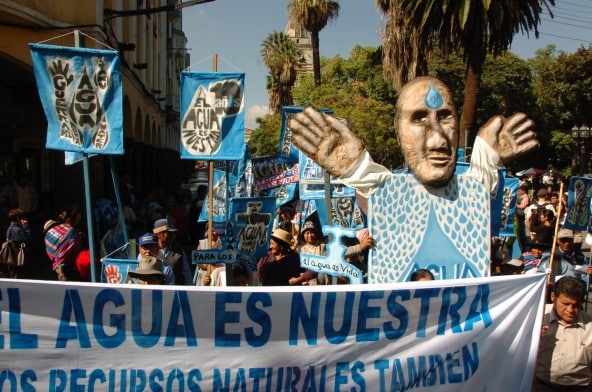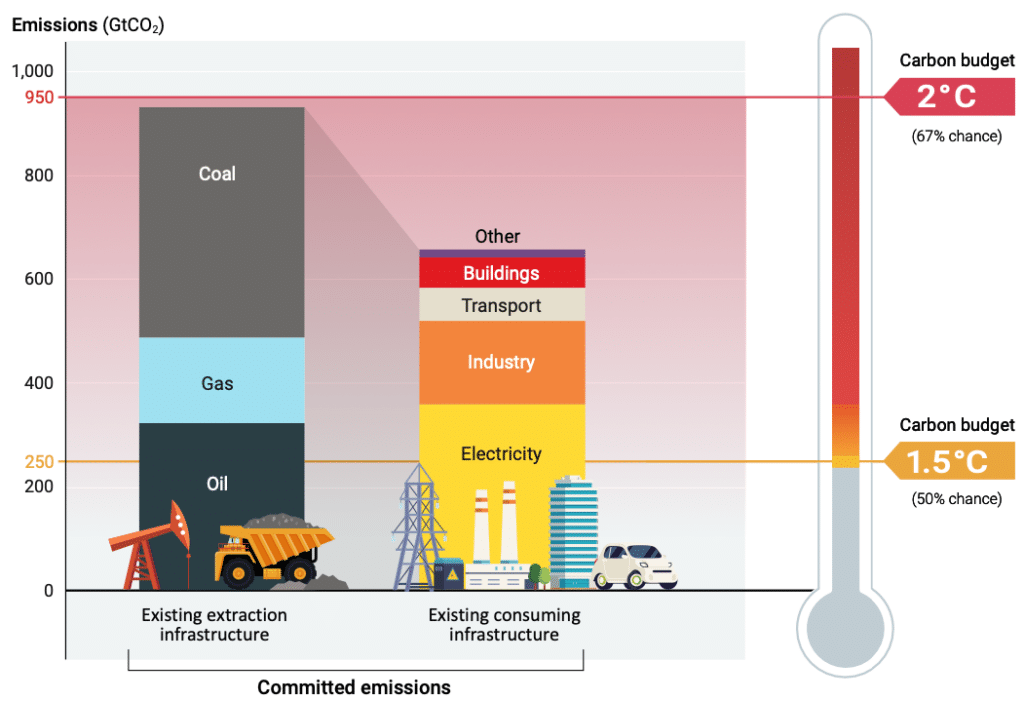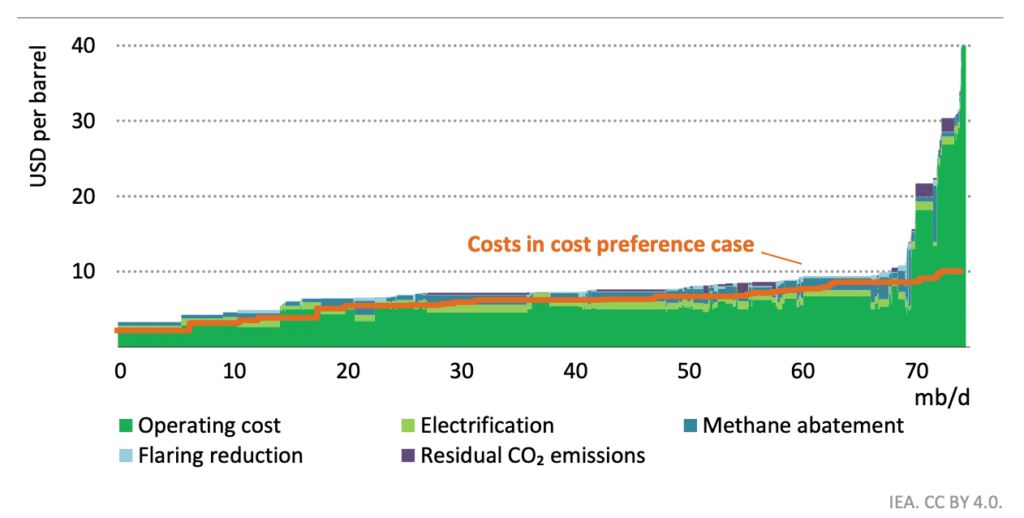Mirages in the desert occur when hot air bends light in such a way that it acts as a mirror, inverting reality. The delusionary effect of the mirage is that there is a pool of water shimmering in the far distance. Desperate thirst impels the traveller onwards towards the mirage. But each time it recedes ever further afar, until the exhausted traveller collapses and dies, cruelly tortured by the deception. The mirage is a real illusion.
The COP28 summit taking place in Dubai, United Arab Emirates from 30 November to 12 December is a colossal illusion, a mirage in the desert. Certainly, there will be much hot air. The delusionary effect is that the capitalist system is capable of reforming itself sufficiently to prevent global climate catastrophe, even as all the evidence points to the opposite conclusion.
Amongst the swathe of reports published on the eve of the summit, the stark message of the latest UN Environment Programme report stands out: on current policies the planet will most likely warm by an average of 2.9°C this century, there is only a slim chance of limiting warming to 1.5°C. UNEP’s Emissions Gap Report 2023 – subtitle ‘Broken Record – Temperatures hit new highs, yet world fails to cut emissions (again)’ – is even graver than all other mainstream scientific warnings.1
Science and experience agree: environmental catastrophe is upon us
There will be a stock taking at COP28, the culmination of eight years of hypocrisy and dirty deals since the targets of 1.5°C and 2.0°C were set at the Paris COP in 2015. But Paris was itself a compromise beyond the safe limit of 1°C that was proposed by Evo Morales of Bolivia at the Copenhagen COP in 2009, but rejected by the major capitalist powers.2
The planet has since already passed the safe limit, we are into the danger zone in so many ways.3 COP28 is a grand show of concern that will raise false hopes in the current system’s capacities at the very moment when what is needed is a revolution of thought and in action.
The unfolding disaster has a physical causal chain that runs from the burning of fossil fuels to the emission of green house gases (GHG) to the heating up of the planet’s surface to multitudinous, overlapping and accelerating environmental impacts.4 Such a totalising problem has to be addressed from all possible angles, but there is one inescapable crunch point: if there is not an immediate wholesale cut in fossil fuel combustion, all other attempted solutions will fail.
Cumulative Emissions Already Put the World in Danger Zone
Unless current production is cut drastically, the world is already past the ‘carbon budget’ of cumulative Green House Gas (GHG) emissions, that would limit global warming to 1.5°C, and is on the cusp of breaching the budget to stay within 2°C. UNEP reports: “coal, oil and gas extracted over the lifetime of producing and under-construction mines and fields as at 2018 would emit more than 3.5 times the carbon budget available to limit warming to 1.5°C with 50 per cent probability, and almost the size of the budget available for 2°C.”5
Figure 1. Committed CO2 emissions from existing fossil fuel infrastructure compared with carbon budgets reflecting the long-term temperature goal of the Paris Agreement.
The whole point of fossil fuels is that they burn, they give off their stored calorific energy, it is in their nature. An environmentally rational humanity would limit their use under controlled conditions. In the capitalist system fossil fuels continue to be highly profitable to extract and process as commodities, and they are deployed profitably as inputs to many industrial processes as well as end-use burning. Cheap fossil energy is embedded in the capitalist way of life, absolutely so in the blatant luxury consumption of the super-rich, but also to a degree by wider populations privileged to have imperialist modes of living, and further with even greater contradictions for the mass of working humanity in the Majority World (Global South).6
What passes for capitalist ‘civilisation’ runs on the release of fossilised carbon, especially in transport, heating and increasingly petrochemicals.7 Corporations and capitalist states built around profitability as their determining essential character will not voluntarily give up their surplus-profits gained from fossil fuels.
The target is to limit the global average temperature rise over pre-industrial temperatures. There are two points to bear in mind about average. Firstly, averaging over time, with the target figure being averaged over a decade or more. But in any given month there could be considerable overshoot, as in September and October 2023 where the rises were 1.8°C and 1.7°C respectively,8 although the smoothed longer-term average is as yet considered to be 1.2°C above the pre-industrial level.
Secondly the averaging is across the surface of the globe. At 1.1°C the average ocean temperature is 0.9°C above, whereas land masses are 1.4°C over pre-industrial levels. There were particularly high increases of over 3°C in the central landmasses of all the continents.9 Regional fluctuations of meteorological conditions drive temperatures even higher with catastrophic results; as in India, Southern Europe, Northern America earlier this year, and Brazil right now.10 Parts of the Arctic are warming seven times faster than the global average, threatening a tipping-point of accelerated melting ice caps, that would raise sea levels all over the world.11
At a local level within cities, the extreme differences in ambient temperatures are down to class inequalities, as in Mumbai where people in the shacks of Dharavi suffer 6°C hotter than the neighbouring rich district.12 The World Meteorological Organisation details how most healthcare is inadequate for dealing with global heating. “Between 2000 and 2019, estimated deaths due to heat were approximately 489,000 per year”; ten million people have died.13
It’s the Profits, Stupid!
Time has run out, yet the perverted show of COP’s annual meetings trundles on. Despite the overwhelming evidence before the world’s national governments assembled for COP28, still their horse trading means this urgency will be diverted and lost, and the drastic measures required will once again be kicked down the line.
What solutions are being proposed? The International Energy Agency (IEA) was set up by the OECD club of rich nations to coordinate their policies after the first oil price hike in 1973. The IEA has been championing a switch to renewable energy sources (wind and solar) on the grounds that their costs of production have come down rapidly and are now comparable to the cost of a kilowatt hour (kWh) of electricity produced by fossil fuels.14
This trust in the market is misplaced, the authoritative tone of the IEA disguises its projections are based on sand, that will blow away at the first gust of capitalist self-interest. As Brett Christophers and others argue, the IEA’s ‘cost centric’ approach misses the essential point, what matters to capitalist investors is the profits that are achieved. “To understand the economics of the energy transition, we should adopt a “profit-centric” perspective, rather than a cost-centric one.” Internal rates of return (IRRs) are the profits over time less the cost of financing, used by companies to assess investment projects. Crucially, the IRRs of hydrocarbon projects are “around 15% to 20%, or higher”, whereas “typical IRRs on renewables today are around 5% to 6%.” 15 although the majors think they can do better than existing renewables companies and lift returns to about 10%. In fact, 10% profitability is the recent average for UK business capital. 16
Hydrocarbon production generates much more than average profitability, at least twice as much as renewables. There is debate on this: McKinsey reports median upstream hydrocarbon IRRs declining from 2010 to 2020 at around 25%;17 the IEA is more optimistic in favour of renewables, arguing that “oil and gas projects currently produce slightly higher returns on investment, but those returns are less stable.”18
Yet the super-majors continue to expand production on the expectation of higher-than-average profit returns. UK based Shell expects IRRs of 30% on its brownfield expansion in the Gulf of Mexico.19 BP’s expected returns from investments in renewables are in the 6% to 8% range, whereas its minimum hurdle for investing in new oil and gas projects is 15% to 20%, which is conservative as it assumes crude will sell at $60 a barrel; at $70 a barrel the rate of return would be in the 20% to 25% range.20 BP had declared in 2019 that it would scale down hydrocarbon production by 40% by 2030, but this target was subsequently reduced to a 25% cut, which the shareholders still do not like and is in any case not being met. It is only in its messaging that BP is an outlier amongst the big oil companies.
In October 2023 the two US giants ExxonMobil and Chevron bought other companies in mega-deals to considerably increase their production capacities to 5.1 million barrels of oil a day (mb/d) and 4.4 mb/d respectively.21 Exxon is now moving into lithium mining because “the returns on lithium projects are also higher than renewables and more in line with oil and gas.”22
Competing Scenarios of Oil and Gas Demand
Much of the debate crystallises around different demand projections for oil over the next thirty years. The Financial Times asks will we reach the much vaunted ‘peak oil’ within this decade? Will then green transition policies really begin to bite and oil production decline significantly to 2050? Or will demand actually increase and profitable production continue to expand? Or, finally will oil and gas production plateau at just over current levels? The last option is increasingly the most likely, not just because it is the mid-point scenario, but radical change within the current world system is just not happening. All of this makes for, the FT concludes, ‘an age of energy uncertainty’.23
To highlight this, compare the IEA’s projections with those of oil producer group OPEC. The IEA posits three scenarios, similar to the reference scientific study by the IPCC and many other reports. In its stated policies scenario, the IEA projects that oil production will increase by about 5% to reach a peak of 99 mb/d by 2030 and from then decline slightly to about the same level as today. In this scenario oil prices remain at $85 a barrel. The scenario to reach net zero by 2050, would by 2030 already require a drastic reduction in the world’s oil production, and a (highly unlikely) price drop to just $40 a barrel, with the result that ‘high cost producers are pushed out of the market’. 24 It is notable that in this scenario 90% of the world’s oil would be supplied from the low cost Middle East producers.
Figure 2 Costs of oil production in the NZE Scenario and cost preference case 2030.
The net zero path is the necessary course to save the planet, yet it is completely unrealistic counter-factual within the capitalist mode of production. The IEA introduces a third scenario, mid-way between the two, but still requiring a worldwide programme of radical reforms well beyond what is on offer at COP28.
In another report by the same organisation, the IEA projects an increase in demand of 6 mb/d from 99 mb/d in 2023 to 106 mb/d in 2028, 90% of which coming from Asia Pacific region, concluding that “While a peak in oil demand is on the horizon, continued increases in petrochemical feedstock and air travel means that overall consumption continues to grow throughout the forecast.”25
The IEA’s more optimistic scenarios conform to its enlightened reform out of self-interest position within the establishment. Its strategy is to urge corporate capitalism to do the right thing. The energy multinationals are central to its transition strategy. And yet they are just not playing ball. This led to IEA’s director Fatih Birol to complain “Oil and gas companies spend about 2.5% of their capital on clean energy technologies such as renewables and electric vehicle charging, compared with 97.5% on traditional business areas.”26
OPEC is franker about continuing profit opportunities for hydrocarbon producers; it sees demand for oil increasing significantly in the short term from 2022 level of 91 mb/d to 102 mb/d by 2030, and then continuing slight annual increases, to 106 mb/d in 2045. OPEC estimates that gas production will increase considerably from 67 to 87 mboe/d (oil equivalent barrels a day), and it projects a significant drop in coal production from 76 to 54 mboe/d. OPEC predicts that in combination fossil fuel production will increase from 234 mboe/d in 2022 to 248 mboe/d in 2045.
Currently wind and solar renewables supply just 8 mboe/d, under 3% of the total primary energy supply; with rapid growth they would reach 12% of global energy supply by 2045. The proportion of fossil fuels to total supply is currently just over 80%, and in OPEC’s prediction it declines to 69% in 2045 – the remainder is from nuclear, hydro and biomass. OPEC sees the share of all renewables including hydro and biomass increasing from 15% to 23% of all primary energy in 2045.27
In broad picture terms, the rapid expansion of renewable energy is from a very low starting point and, at best, will probably be barely enough to meet growing demand. That leaves continuing fossil fuel production at or just above current levels. The weight of fossil fuels would then decline in relative terms but probably not absolutely. That is, the current rate of GHG emissions from burning fossil fuels will continue at present levels or tend to rise. Yet, to repeat the obvious, we are already at or even past the safe limit of cumulative emissions.
Profitability is the cardinal vector that is pushing the world into catastrophe. Profits depend on the gap between operating costs and commodity prices on the world market. BP’s overall profit projections are based on an estimated price of $70 a barrel of crude in 2030, and Shell is a bit more conservative at $65 a barrel beyond 2026.28 These corporations decide on expanding production at $30-40 a barrel break-even costs, that is with a profit margin of $35 and more a barrel. At these margins they will continue to expand production and draw huge profits.
It is not only the Western corporate super-majors, but the big state oil corporations of the Middle East (West Asia) that are pursuing the path of expanding demand for fossil fuels that will hold prices up near the current $75-80 range, and therefore increase production at even higher profits since they produce at less than $10 a barrel. Andreas Malm points out that Saudi’s Aramco made more profits in 2022 than any other company has ever done, and he is certainly right that the centres of global capitalism have already settled that the world is going to heat up towards the catastrophic 3°C heat increase, and are now intent on managing the narrative with tendentious claims of future technical fixes to bring the planet back to 1.5°C. Malm argues that the failure to switch to renewables is capitalist protection of their private property, in particular the sunk costs of hydrocarbon assets and infrastructures built around them risk becoming unprofitable, the so called ‘stranded assets’. 29
Stranded Assets or a Defunct System?
The risk of stranded assets has been used to lobby finance into switching out of hydrocarbons.
Figure 3. Carbon Tracker Initiative. Image source: The Climate Alliance, “Stranded assets in the fossil fuel industry and why they are important,” 1 April 2016.
As the graphic shows the Carbon Tracker Initiative warns that “fossil fuel companies risk destroying investor returns”. It seeks to “align capital market actions with climate reality.”30 The problem is that climate realities are subordinated to capital markets, not the other way round, and wishful thinking will not change that. This really is the nub.
The problem is that the carbon super-majors and the asset funds that back them are not biting on this hook. As we have seen, although the oil companies have increased their investment in renewables somewhat this is still only at the margins, leaving hydrocarbons at over 97% of their production.
The problem is that the big banks and asset managers are ploughing huge funds into fossil fuel extraction, they are ‘banking on climate chaos’, to the tune of “$5.5 trillion in the seven years since the adoption of the Paris Agreement”. 31 The counteracting effect of shifting investment through ethical and green finance is massively over-hyped. A recent study found that less than 5% of the finance capital placed in environmental, social, and governance (ESG) funds is actually consistent with 1.5°C.32
Fossil fuel producers are expanding production, despite claims and promises, on their calculation of future profits. Just in the Americas: Canada has missed every single emissions reduction target since the tar sands were opened up; 33 in the US, rapid development of the Permian field and fracking have made it the world’s biggest producer; and huge new plays deep under the Atlantic Ocean are being pursued off Mexico, Guyana, Suriname, Brazil and Argentina.34
There is no good COP, it’s all bad COP.
If you think that this version of capitalism is bad, wait until you see the next one. The core groups of world capitalism are set on a course for average 2.9°C increase by 2100. Everything will get worse.
There is a sharpening polarisation in mass politics within the rich industrialised countries, whose populations are socialised in imperial modes of consumption but at least with a conscious minority now taking militant action to save the planet; the polarisation between countries that starts with the basic rupture of the ‘North/South’ divide in a world system still profoundly shaped by the legacy of the colonisers and the colonised; and compounded by the divergent interests of producers and consumers.

Figure 4. Global North and South Divide. Image source: Hesperian.
The politics of climate change has to shift towards bringing together all the grass roots movements, a rekindling of the spirit and ambition of the Cochabamba social movement conference reconstructed democratically.35 The ‘zones of sacrifice’ are the zones of resistance on the frontline, as in the case of Total’s EACOP pipeline in Uganda. 36 Despite their criminalisation the environmental defenders continue to fight, and are drawing solidarity actions around them.37
The fundamental solution will come from the many, many indigenous and impoverished communities in the Majority World who are mobilised in confrontation with extractive capitalism for their very survival emerging at the centre of a global alliance of working people.
As we go to press it has just been reported that the person put in charge of COP28 has been briefed to make side deals to sell oil and gas under cover of climate change meetings.38 You really could not make this up, it is the clearest indication of the perverted process on which the future of the entire planet and humanity depends.
We have so reached the end of the road. Under capitalist, that is to say imperialist, relations of production the challenge to put a stop to climate catastrophe is impossible. There is one conceptual step further than the profit centred approach. We need to grasp that the pursuit of surplus-profits (Marx) or super-profits (Lenin) is the economic driver underpinning why capitalist imperialism is destroying the planet.
Given how much our societies already rely on fossil fuels, constructing an equitable and ecologically sustainable socialist system starting from the existing material base will be an immense challenge. One thing is clear, saving life on earth means that we have to destroy capitalist imperialism.
Revolution, not reform, is the only life affirming answer to the capitalist mirage in the desert.
Notes
- ↩ UNEP (2023) Emissions Gap Report 2023, unep.org.
- ↩ ‘Evo Morales stuns Copenhagen with demand to limit temperature rise to 1C’ The Guardian 16 December 2009
- ↩ Steffen, Will et al. (2018) ‘Trajectories of the Earth System in the Anthropocene’ PNAS August 14, 2018 115 (33): 8252-8259 pnas.org; and Climate Reality Check (2021) Climate Reality Check, climaterealitycheck.net.
- ↩ von Schuckmann et al (2020) ‘Heat stored in the Earth system: where does the energy go?’ Earth System Science Data, essd.copernicus.org.
- ↩ UNEP (2023), p. xxiii.
- ↩ Oxfam International (2023) Climate Equality: A Planet for the 99%, policy-practice.oxfam.org.
- ↩ See Adam Hanieh (2021) ‘Petrochemical Empire’ New Left Review 130, pp25-41.
- ↩ Copernicus, “2023 on track to become the warmest year after record October,” 10 November 2023, climate.copernicus.eu.
- ↩ World Meteorological Organization (WMO) (2022) United in Science 2022 ; WMO (2022) State of the Global Climate 2022 (WMO-No. 1316), library.wmo.int.
- ↩ ‘‘Hell de Janeiro’: scorching heat highlights Brazil’s glaring inequality’ The Guardian 19 November 2023
- ↩ ‘New data reveals extraordinary global heating in the Arctic’ The Guardian 15 June 2022
- ↩ Oxfam International (2023), p32.
- ↩ WMO (2023) 2023 State of Climate Services: Health, library.wmo.int.
- ↩ IEA (2023) World Energy Investment 2023, iea.org. See also IPCC (2023) AR6 Synthesis Report: Climate Change 2023, ipcc.ch.
- ↩ Brett Christophers 2021 ‘Big oil companies are driven by profit – they won’t turn green by themselves’ The Guardian 25 May 2021
- ↩ UK Office of National Statistics 2023 Profitability Dataset, Profitability of UK companies time series, ons.gov.uk.
- ↩ McKinsey ‘The big choices for oil and gas in navigating the energy transition’ 10 March 2021, mckinsey.com.
- ↩ IEA (2023) The Oil and Gas Industry in Net Zero Transitions https://www.iea.org/reports/the-oil-and-gas-industry-in-net-zero-transitions
- ↩ Shell (2023) Capital Markets Day, nevirpedia.nl.
- ↩ BP (2023) 2022 Full Year and 4Q: Financial Results and Update on Strategic Progress, bp.com ; pp19-30.
- ↩ ‘Dealmakers see Chevron-Hess tie-up as the start of oil “arms race”’ The Financial Times 24 October 2023
- ↩ ‘Exxon to begin producing lithium to feed surging battery demand’ The Financial Times 14 November 2023
- ↩ ‘Oil megadeals usher in an age of energy uncertainty’ The Financial Times 25 October 2023
- ↩ IEA (2023) The Oil and Gas Industry in Net Zero Transitions, p54.
- ↩ IEA (2023) Oil Analysis and forecast to 2028, iea.blob.core,p28.
- ↩ ‘Companies still investing too much in fossil fuels, global energy watchdog says’ The Guardian 23 November 2023
- ↩ OPEC (2023) World Oil Outlook 2023, woo.opec.org.
- ↩ Shell (2022) 2nd Quarter 2022 And Half Year Unaudited Results https://www.shell.com/investors/results-and-reporting/quarterly-results.html
- ↩ Andreas Malm (2023) Interview on Palestine, Climate Activism and over-shooting 1.5 °C, youtube.com
- ↩ Carbon Tracker Initiative ‘Aligning capital market actions with climate reality’ https://carbontracker.org
- ↩ Rainforest Action Network et al (2023) Banking on Climate Chaos: Fossil Fuel Finance Report 2023, bankingonclimatechaos.org.
- ↩ Fichtner et al (2023) ‘Mind the ESG capital allocation gap: The role of index providers, standard-setting, and “green” indices for the creation of sustainability impact’ Regulation & Governance
- ↩ UNEP (2023) Production Gap Report 2023: Phasing down or phasing up? Top fossil fuel producers plan even more extraction despite climate promises unep.org.
- ↩ ‘Oil still looks like an easier bet for Latin America than renewables’ The Financial Times 14 November 2023
- ↩ ‘Grassroots summit calls for international climate court’ The Guardian 23 April 2010
- ↩ Human Rights Watch (2023) Uganda: Oil Pipeline Protests Stifled, hrw.org.
- ↩ Just Stop Oil (2023) ‘Students paint Total Energies HQ in resistance to Ugandan pipeline atrocities’ juststopoil.org. See also Fossil Free London https://fossilfreelondon.org
- ↩ ‘UAE planned to use COP28 summit for oil deals, documents show’ The Financial Times 27 November 2023



